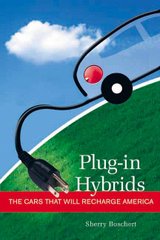Bob Lutz, GM CEO, sat down to chat with some bloggers at the NY Auto Show, and
PODTECH has the video. Well worth a listen. Lutz responds to the sense that GM might be pulling back from its commitment to the Volt that resulted from
Sharon Terlep's Detroit News article a month or so ago. (My take at the time
here.)
Lutz says the Volt is no "pr stunt," that they intend to have a working model by the end of the year, and are making a diesel version with a European body to be shown in Frankfort. While the goal is still a 2010 release, everything hinges on the Lithium battery thought to be the essential heart of the Volt. And there's the rub. Must the battery really be lithium to get this radically different automobile off the drawing board and into the showroom? Or is lithium the new hydrogen? Simply the latest industry stalling tactic.
Asked why not Nickel Metal Hydride batteries in the Volt, at least to start, he says "NiMH just doesn't do it." It would take more weight to reach 40 miles, he says. And nickel mining is such dirty business we ought move right to benign lithium. But hold on. What's so sacrosanct about 40 miles? And is Lutz - purveyer of Hummers and Escalades - suggesting the environmental consequences of nickel mining are so great we must wait for lithium? Interestingly, Lutz says GM is being approached by NiMH manufacturers to use this proven battery chemistry in the Volt. And if Lithium proves problematic, he says GM will again consider NiMH.
This makes no sense. If you've got the desire to introduce a radically different car, why not simplify the effort by using the best available mature battery technology in the inevitably small-run first generation? If you've got hundreds of millions of trouble-free NiMH miles in hybrids and electric cars, why bet the bank on relatively untested if promising lithium?
Perhaps Lutz's mistaken impressions about the EV1 and electric cars color his understanding of what NiMH can achieve. (Or perhaps GM's disinformation campaign about the successes of the EV1 and its NiMH batteries is still in force.) He says the EV1 got 60-70 miles (actually double that), and very few were sold (actually none were sold) because people were afraid of getting stuck in LA traffic watching their charge go down ("stuck in traffic" requires virtually no energy.) Could Lutz not know the range of an EV1?
Lutz decries the lack of interest by the federal government in the "transformational technology" represented by the Volt.
We're curiously disappointed with all the talk about CO2 in Washington and we have to put industry's feet to the fire and improve fuel economy. Nobody really asks wouldn't it be smarter to put more energy into what you guys are doing with the Volt.
Congressional efforts (and he might add environmental leadership at NRDC, UCS and the Sierra Club) are stuck on gasoline efficiency when it's time to move to technologies with the promise of getting us off petroleum.
"We are beyod the point of diminishing returns on the internal combustion engine. It's time to make a paradigm shift."
Lutz expresses his belief in the benefits of transitioning to the electric grid, lessening our need for liquid fuels by using them merely as range extenders for an electric car. And I couldn't agree more. Does he mean it? Or is he simply asking to feed again at the federal trough, millions for lithium research much like the PNGV or various hydrogen and fuel cell research subsidies that have brought us neither fuel choices nor even high mileage gasoline vehicles.
If Lutz means it, GM should be willing to meet higher CAFE requirements with electric miles in the Volt, rather than ethanol flex-fuel loopholes.
If Lutz means it, GM should have no objection to a reinvigorated ZEV mandate in California. If he means it, GM should be working with CARB right now to include plug-in hybrids with all-electric range in the revised mandate.
If Lutz means what he says about the great benefits of the "E-Flex architecture," (what's more commonly known as a serial hybrid,) GM would demonstrate some real e-flexibility, and build a NiMH Volt now. GM doesn't need a fancy new package. And it doesn't need to have a $20,000 MSRP. There is a market for plug-in cars now.




